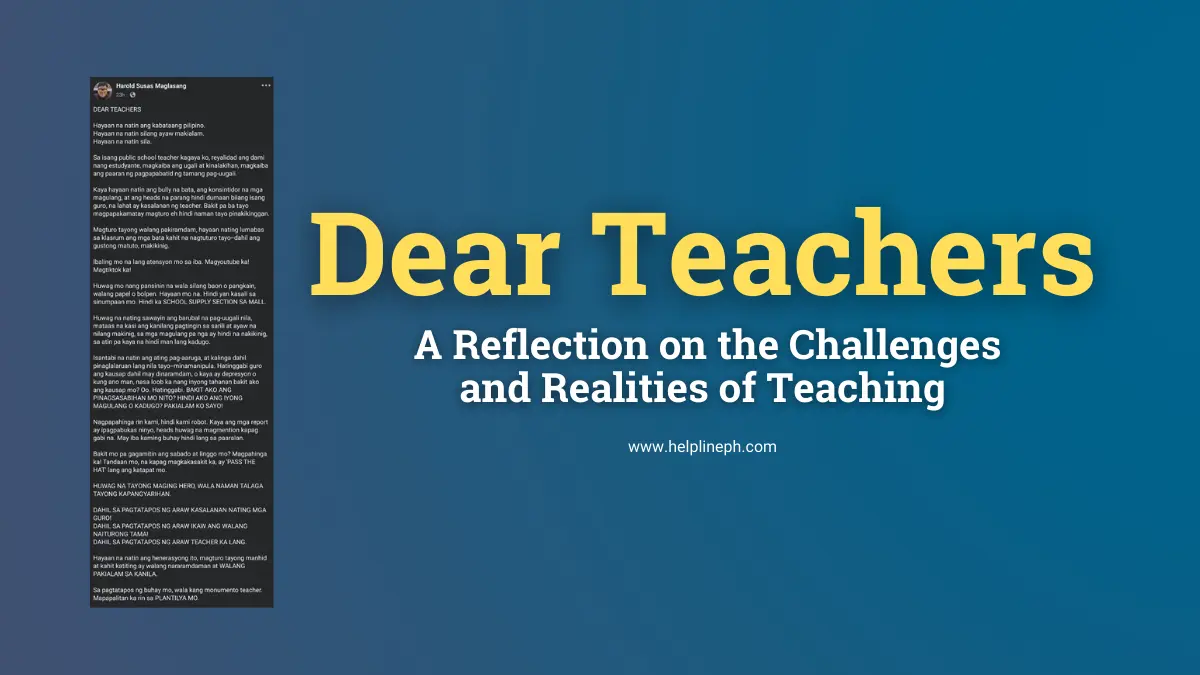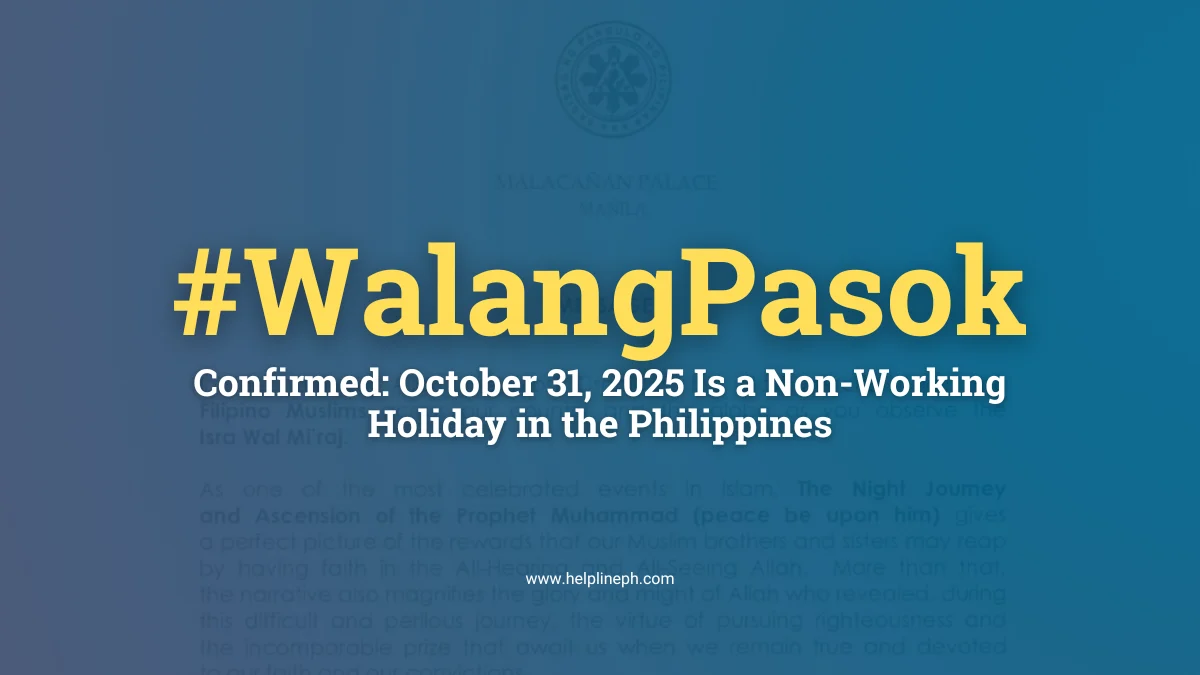Teaching today comes with countless challenges. A viral poem shared by a frustrated educator vividly expresses the struggles teachers face daily, both inside and outside the classroom. It paints a picture of how overwhelming the profession has become and highlights the high expectations placed on teachers while offering little support. These words capture the frustrations and emotional toll of a profession that often goes unappreciated.
The Challenges of Modern Teaching
The poem opens with a bold statement: “Hayaan na natin ang kabataang Pilipino. Hayaan na natin silang ayaw makialam.” This can be understood as a cry for teachers to step back from the impossible task of trying to solve everything. Students come from diverse backgrounds, each with their own personalities, upbringings, and behaviors. In a single classroom, teachers must balance the needs of students who may be very different from each other, which can be exhausting and overwhelming.
Dealing with Bullies and Difficult Students
One of the major issues the poem tackles is the presence of bullying and difficult students. Teachers are often expected to handle these problems alone, but it’s not that simple. Some parents defend their children’s bad behavior, and sometimes school administrators don’t fully understand the daily struggles teachers face. When problems arise, it’s common for the teacher to be blamed.
“Lahat ay kasalanan ng teacher,” the poem says, reflecting how teachers are often held responsible for everything—from a child’s bad behavior to their poor academic performance. This shows how much pressure is placed on teachers, even in situations beyond their control.
The Struggle to Be Heard
Another powerful message in the poem is the sense that teachers are no longer being listened to by students, parents, or even the school system itself. “Bakit pa ba tayo magpapakamatay magturo eh hindi naman tayo pinakikinggan?” This line expresses the frustration of trying to teach when students show no interest, and parents or administrators fail to support the teacher’s efforts. For many educators, it feels like they’re talking to a wall.
Emotional and Mental Burnout
Perhaps one of the most striking lines in the poem is: “Magturo tayong walang pakiramdam, hayaan nating lumabas sa klasrum ang mga bata kahit na nagtuturo tayo—dahil ang gustong matuto, makikinig.” This speaks to the emotional exhaustion many teachers feel. It’s a call to detach emotionally from the job because giving too much can lead to burnout, especially when students seem uninterested or disengaged.
The Reality of Limited Resources
Teachers often find themselves going above and beyond their role as educators. Many take on the responsibility of providing their students with basic supplies like food, paper, or pens when they can’t afford them. The poem addresses this issue, saying, “Huwag mo nang pansinin na wala silang baon o pangkain, walang papel o bolpen.”
This sheds light on a deeper problem: the lack of resources in schools. While teachers are expected to do their best, they are often left to fill in gaps that the school system and government fail to address. For many educators, this additional burden only adds to their already overwhelming workload.
Teachers as Emotional Support
Teachers are not just responsible for students’ academic growth—they often serve as emotional support for their students as well. The poem mentions how teachers are contacted late at night by students dealing with personal issues, such as depression. “Hatinggabi guro ang kausap dahil may dinaramdam, o kaya ay depresyon o kung ano man.” This line shows the emotional burden teachers carry, even outside school hours.
While teachers care deeply for their students, this emotional responsibility can be overwhelming. They are not trained counselors, yet many find themselves helping students through difficult personal situations, sometimes sacrificing their own mental well-being in the process.
The Call for Self-Care
The poem also sends a crucial message to teachers about self-care. “Bakit mo pa gagamitin ang sabado at linggo mo? Magpahinga ka!” Teachers are reminded that they need to take care of themselves. It’s important for educators to recognize that they cannot give endlessly without recharging their own energy. The poem encourages teachers to set boundaries, reminding them that they are human, not machines.
In a world where teachers are expected to be available at all times—whether for grading papers, answering emails, or preparing lessons—it’s vital for educators to prioritize their own health and well-being. After all, a burnt-out teacher cannot effectively help their students.
The Myth of the Hero Teacher
The poem challenges the idea of the “hero teacher” by stating: “HUWAG NA TAYONG MAGING HERO, WALA NAMAN TALAGA TAYONG KAPANGYARIHAN.” This line suggests that society often places unrealistic expectations on teachers, viewing them as superheroes who can single-handedly fix all problems in education.
But teachers are only human. They cannot solve every issue or magically transform every student’s life. This message speaks to the importance of giving teachers realistic expectations and the support they need to do their job effectively. Without proper resources and understanding, teachers are set up to fail, regardless of how hard they try.
The Burden of Blame
The final lines of the poem highlight the burden of blame placed on teachers. “DAHIL SA PAGTATAPOS NG ARAW KASALANAN NATING MGA GURO! DAHIL SA PAGTATAPOS NG ARAW IKAW ANG WALANG NAITURONG TAMA!” These lines express the harsh reality that, at the end of the day, teachers are often blamed when students don’t succeed.
This speaks to the unfair pressure placed on educators. No matter how much effort they put into their work, they are still held responsible for outcomes beyond their control, whether it’s a student’s poor performance or the lack of proper support from parents and administrators.
Viral Poem

Credits: Sir Harold Susas Maglasang
Conclusion
“Dear Teachers” captures the frustration, exhaustion, and emotional toll that teachers experience in today’s world. It sheds light on the many roles educators take on, often at the expense of their own well-being. From providing emotional support to filling in for inadequate resources, teachers are expected to do it all while being blamed for failures that are beyond their control.
Teaching is one of the most challenging and noble professions, but it’s clear from the poem that educators need more support, understanding, and resources to continue doing their jobs effectively. Teachers care deeply about their students, but they must also take care of themselves. After all, they can only truly help their students if they are in a good place emotionally and mentally.






